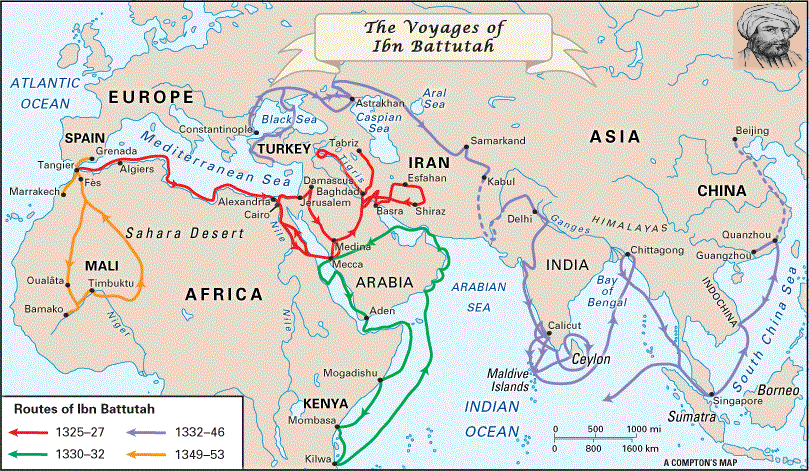Introduction: Ibn Battuta’s Remarkable Expeditions
Ibn Battuta, hailed as one of history’s preeminent Muslim explorers embarked on an extraordinary journey spanning over 40 countries across three ancient continents. His unprecedented travels covered a staggering distance exceeding 120,000 kilometers. From Morocco to China, Malaysia, and the Philippines, he traversed paths no other traveler had ventured before. His remarkable exploits earned him the illustrious title of “the prince of Arab Muslim travelers” by a prestigious university, comparable in stature to Cambridge.
Early Life and Upbringing
Born in 1304 in Tangier, Northern Morocco, to the Berber “Luata” tribe, Ibn Battuta’s lineage is traced back to Libya’s Cyrenaica region. His name’s origin is speculated to stem from his mother’s name, Fatuma, a common practice of naming children after their mothers during that era. Raised in a family renowned for legal studies and judiciary practice during the Marinid state, he fostered a profound love for science and learning, inheriting an Islamic education customary in North African countries.
The Grand Odyssey Begins
At the age of 21, what began as a pilgrimage to Mecca for Hajj transformed into an extensive 30-year odyssey. His explorations spanned the Eastern Hemisphere, encompassing nearly all of the Islamic world. Ibn Battuta’s vast knowledge acquired during these travels led him to unprecedented experiences and adventures.
The Epic Chronicles of Travel
In his seminal work, “Tuhfat al-Nazar fi Oddities of the Lands and Wonders of Travel” or “Ibn Battuta’s Journey,” he vividly recounts his solitary departure from Tangier in 1324. His odyssey took him through Algeria, Tunisia, and Libya to the awe-inspiring city of Alexandria. From there, he journeyed to Cairo, describing its distinct quarters and historical significance.
Unforgettable Encounters and Descriptions
Ibn Battuta’s sojourn led him to Bethlehem, Jerusalem, and the revered Al-Aqsa Mosque lauded as one of the most magnificent mosques globally. His detailed descriptions extended to the Dome of the Rock, a mesmerizing edifice adorned with intricate craftsmanship and splendor.
Traversing Continents and Cultures
His travels spanned continents, leading him through cities ravaged by historical conflicts, such as Acre, devastated by the Crusades. His journey continued through Iraq, Basra, Baghdad, and Persia, each stop offering unique insights into diverse cultures, architectures, and landscapes.
Epic Maritime Ventures and Diplomatic Engagements
Ibn Battuta’s seafaring ventures carried him across the Indian Ocean to Somalia, Tanzania, and India, where he served as a judge for the ruler Muhammad Tughlaq. His encounter with Hindu pirates and tempestuous storms underscored the perils he faced during maritime travels.
Legacy Beyond Exploration
Not confined to exploration, Ibn Battuta served as a judge and ambassador in various countries, earning appreciation for his scholarly prowess. He received financial aid and hospitality, enabling his extended journeys and chronicling his experiences.
The Literary Masterpiece: “The Journey”
His extensive experiences, penned meticulously in “The Journey,” were later documented by the scribe Muhammad Ibn Jazi Al-Kalbi Al-Gharnati. This literary work, translated into numerous languages, vividly portrays Ibn Battuta’s encounters, lifestyles, and political landscapes.
Legacy and Uncertainty
The exact date of Ibn Battuta’s demise remains shrouded in uncertainty, with historical sources citing varying years between 1368 and 1377. Despite this ambiguity, his legacy endures as an unparalleled explorer, chronicler, and cultural bridge across civilizations.
